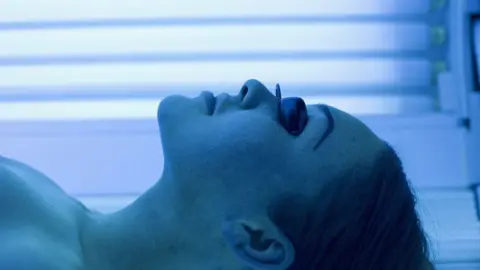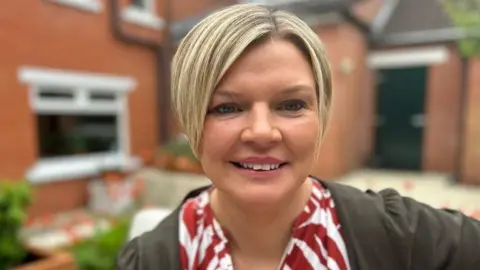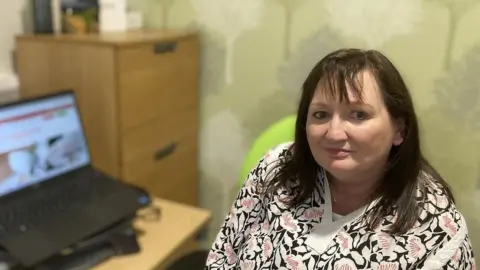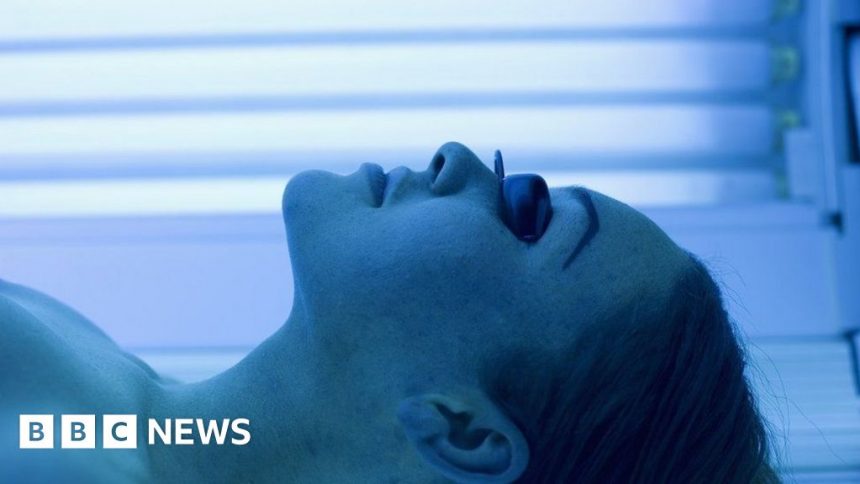Insane not to ban sunbeds in NI – skin cancer expert
 Getty Images
Getty ImagesIt is “insane” sunbeds are not banned in Northern Ireland as they are elsewhere in the world given their links to skin cancer, an Australian dermatologist has said.
Jim Muir said tanning parlours are known to increase the risk of melanoma “very significantly”.
They have been banned in Australia for more than a decade.
It comes as Belfast has been named the “sunbed capital of the UK” after data showed 37% of adults in the city use them.
The research, by the charity Melanoma Focus, also shows that melanoma skin cancer is on the rise in the UK.
Mr Muir spoke to BBC News NI while visiting Northern Ireland to share his experience of working in Australia, the “melanoma capital of the world”.
“It’s mad to go to a tanning parlour. It’s just crazy,” he said, adding that doing so causes premature aging and exposes people to cancer-causing ultraviolet (UV) light.
Mr Muir joked that in Australia “we can get melanoma and skin cancer for free by going outside” but that sunbed users in Northern Ireland “have to pay for it”.
One self-described “sun worshipper” who developed skin cancer told BBC News NI not enough is being done to warn people about melanoma risks.
“You just look at how much we know about smoking and cancer,” said Lyn Stevensen.
“The risk between sunbeds and not protecting yourself in the sun and cancer is as real, but I don’t think we do enough about it.”

What is skin cancer?
The Public Health Agency (PHA) has said skin cancer makes up more than 30% of all cancers detected in Northern Ireland and is usually caused by exposure to UV rays.
It can be divided into two types: melanoma and non-melanoma skin cancers.
Melanoma is a type that can spread to other areas of the body. The most common sign is the appearance of a new mole or a change in an existing mole.
This can happen anywhere on the body, but the back, legs, arms, and face are most commonly affected.
In most cases, melanomas have an irregular shape and more than one colour.
They may also be larger than normal moles and can sometimes be itchy or bleed.
According to figures from the NI Cancer Registry, there are about 400 cases of malignant melanoma each year in Northern Ireland, with an average of 60 deaths per year.
Non-melanoma skin cancer is more common and usually less serious – figures show less than 4,000 cases per year on average, with about 1% of those resulting in death.

Who can get skin cancer?
Factors that increase the chances of getting melanoma include age, having pale skin, a large number of moles and a family history of skin cancer.
But the main cause is exposure to UV rays, which comes from the sun and is used in sunbeds.
Lyn Stevensen was a “self-confessed sun worshiper”, who admits that when she was tanned she “felt healthy, ironically”.
She recalled sitting in her garden in summer 2023, when she noticed a new mole on her knee.
Lyn, a pharmacist, knew about the ABCDE checklist, which can be used to assess the difference between a normal mole and a melanoma.
And that evening, she saw a tweet from Action Cancer about its new skin cancer detection service – and “thought the universe is trying to tell me something”.

When she was diagnosed with malignant melanoma, Lyn was “completely shocked” as she did not suffer from painful sunburn when tanning her skin.
Her cancer was caught early and had not spread. And while she used sunbeds in the past, she added, now “fake tan and factor 50 would be the rules I live by”.
“I look at the number of people who are using sunbeds in Northern Ireland and I want to talk to them and say, do you know what, I was like you, and I didn’t think it would happen to me and I didn’t think the risk was there.
“I get the bit around getting a tan because I did feel that lovely healthy glow, but again, it was far from healthy when it was giving me cancer.”
Should sunbeds be banned?
In 2009, the World Health Organisation (WHO) classified exposure to UV sunlamps, sunbeds and tanning booths as carcinogenic.
That same year, Brazil became the first country to ban sunbeds for cosmetic purposes. Australia banned commercial sunbeds in 2013.
In Northern Ireland, under-18s are not allowed to use sunbeds – but for Australian dermatologist Mr Muir this does not go far enough.
“If it’s not safe when you’re under 18, it’s not safe when you’re over 18.
“You do sometimes have to protect people from themselves. We have speed limits, we have seatbelts, we have crash helmets.
“It’s illogical to have exposure to a carcinogen you can avoid. And a strong carcinogen, something that causes cancer.”
The Department of Health has said there are “no immediate plans in respect of a ban on sunbeds”.
It added: “However, given the department’s Skin Cancer Prevention Strategy aims to reduce the incidence of skin cancer, future regulatory measures in relation to sunbeds have not been ruled out.”

How to prevent skin cancer
It is possible to reduce the risk by avoiding sunbeds and tanning booths and being careful in the sun – for example, by using sunscreen and reapplying it regularly.
There are also resources like Action Cancer’s skin cancer detection service, launched in April 2023.
The charity’s senior skin cancer specialist nurse, Iona McCormack, said since it started they’ve “picked up over 100 skin cancers” including 12 to 14 malignant melanoma cases.
She said this was “quite high” and not what they were expecting when they started out.
“Unfortunately, we’ve seen people that have delayed seeking treatment during the time of the pandemic, and since then we’re finding patients are sometimes still reluctant to bother their GP,” she said.
“I think that’s why we’ve probably picked up more than we thought because I think people see this as an alternative service.”







